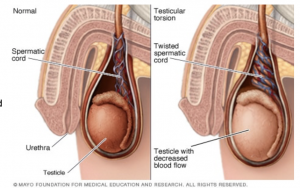Testicular torsion occurs when the testicle rotates on the spermatic cord, which brings blood to the testicle from the abdomen. If the testicle rotates several times, blood flow to it can be entirely blocked, causing damage more quickly.
rotates on the spermatic cord, which brings blood to the testicle from the abdomen. If the testicle rotates several times, blood flow to it can be entirely blocked, causing damage more quickly.
It's not clear why testicular torsion occurs. Most males who get testicular torsion have an inherited trait that allows the testicle to rotate freely inside the scrotum. This inherited condition often affects both testicles. But not every male with the trait will have testicular torsion.
Testicular torsion often occurs several hours after vigorous activity, after a minor injury to the testicles or while sleeping. Cold temperature or rapid growth of the testicle
during puberty also might play a role.
Testicular torsion usually requires emergency surgery. If treated quickly, the testicle can usually be saved. But when blood flow has been cut off for too long, a testicle might become so badly damaged that it has to be removed.
RISKS
Age. Testicular torsion is most common between ages 12 and 18.
Previous testicular torsion. If you've had testicular pain that went away without treatment (intermittent torsion and detorsion), it's likely to occur again. The more frequent the bouts of pain, the higher the risk of testicular damage.
Family history of testicular torsion. The condition can run in families.
A Testis Torsion can cause the following complications:
Damage to or death of the testicle. When testicular torsion is not treated for several hours, blocked blood flow can cause permanent damage to the testicle. If the testicle is badly damaged, it has to be surgically removed.
Inability to father children. In some cases, damage or loss of a testicle affects a man's ability to father children.
When you are discharged, take care of the following:
Take it easy for the first 2 days after the procedure to minimise the risk of bleeding and bruising
Use scrotal support for 10 days
Keep the dressing on for 7 days
The stitches will dissolve by itself
Call the rooms if you experience bleeding, swelling, fever, pain or warm/red scrotum
